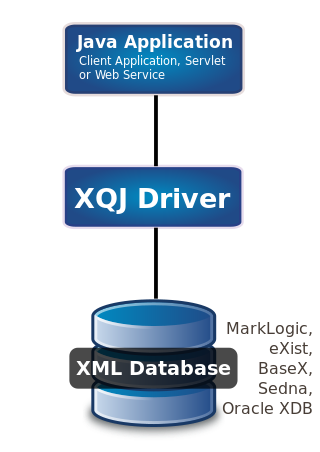Jakarta Enterprise Beans is one of several Java APIs for modular construction of enterprise software. EJB is a server-side software component that encapsulates business logic of an application. An EJB web container provides a runtime environment for web related software components, including computer security, Java servlet lifecycle management, transaction processing, and other web services. The EJB specification is a subset of the Java EE specification.
The Jakarta Transactions, one of the Jakarta EE APIs, enables distributed transactions to be done across multiple X/Open XA resources in a Java environment. JTA was a specification developed under the Java Community Process as JSR 907. JTA provides for:
The Jakarta Messaging API is a Java application programming interface (API) for message-oriented middleware. It provides generic messaging models, able to handle the producer–consumer problem, that can be used to facilitate the sending and receiving of messages between software systems. Jakarta Messaging is a part of Jakarta EE and was originally defined by a specification developed at Sun Microsystems before being guided by the Java Community Process.
Java Platform, Micro Edition or Java ME is a computing platform for development and deployment of portable code for embedded and mobile devices. Java ME was formerly known as Java 2 Platform, Micro Edition or J2ME. As of December 22, 2006, the Java ME source code is licensed under the GNU General Public License, and is released under the project name phoneME.
Java Platform, Standard Edition is a computing platform for development and deployment of portable code for desktop and server environments. Java SE was formerly known as Java 2 Platform, Standard Edition (J2SE).
In computing, the Java API for XML Processing, or JAXP, one of the Java XML Application programming interfaces, provides the capability of validating and parsing XML documents. It has three basic parsing interfaces:
Java Data Objects (JDO) is a specification of Java object persistence. One of its features is a transparency of the persistence services to the domain model. JDO persistent objects are ordinary Java programming language classes (POJOs); there is no requirement for them to implement certain interfaces or extend from special classes. JDO 1.0 was developed under the Java Community Process as JSR 12. JDO 2.0 was developed under JSR 243 and was released on May 10, 2006. JDO 2.1 was completed in Feb 2008, developed by the Apache JDO project. JDO 2.2 was released in October 2008. JDO 3.0 was released in April 2010.
Jakarta Faces, formerly Jakarta Server Faces and JavaServer Faces (JSF) is a Java specification for building component-based user interfaces for web applications and was formalized as a standard through the Java Community Process being part of the Java Platform, Enterprise Edition. It is also an MVC web framework that simplifies the construction of user interfaces (UI) for server-based applications by using reusable UI components in a page.
Java Management Extensions (JMX) is a Java technology that supplies tools for managing and monitoring applications, system objects, devices and service-oriented networks. Those resources are represented by objects called MBeans. In the API, classes can be dynamically loaded and instantiated. Managing and monitoring applications can be designed and developed using the Java Dynamic Management Kit.
In computing, Web-Based Enterprise Management (WBEM) comprises a set of systems-management technologies developed to unify the management of distributed computing environments. The WBEM initiative, initially sponsored in 1996 by BMC Software, Cisco Systems, Compaq Computer, Intel, and Microsoft, is now widely adopted. WBEM is based on Internet standards and Distributed Management Task Force (DMTF) open standards:
The Storage Management Initiative Specification, commonly called SMI-S, is a computer data storage management standard developed and maintained by the Storage Networking Industry Association (SNIA). It has also been ratified as an ISO standard. SMI-S is based upon the Common Information Model and the Web-Based Enterprise Management standards defined by the Distributed Management Task Force, which define management functionality via HTTP. The most recent approved version of SMI-S is available on the SNIA website.
The Mobile Media API (MMAPI) is an API specification for the Java ME platform CDC and CLDC devices such as mobile phones. Depending on how it's implemented, the APIs allow applications to play and record sounds and video, and to capture still images. MMAPI was developed under the Java Community Process as JSR 135.
The Common Information Model (CIM) is an open standard that defines how managed elements in an IT environment are represented as a common set of objects and relationships between them.
The Java API for XML Messaging (JAXM) enables distributed software applications to communicate using XML. JAXM supports both asynchronous and synchronous messaging.
Jakarta Persistence is a Jakarta EE application programming interface specification that describes the management of relational data in enterprise Java applications.
Jakarta RESTful Web Services, is a Jakarta EE API specification that provides support in creating web services according to the Representational State Transfer (REST) architectural pattern. JAX-RS uses annotations, introduced in Java SE 5, to simplify the development and deployment of web service clients and endpoints.
The Common Manageability Programming Interface is an open standard that defines a programming interface between a WBEM server and WBEM providers.

XQuery API for Java (XQJ) refers to the common Java API for the W3C XQuery 1.0 specification.
Jakarta Management is a Java specification request (JSR-77) for standardization of Jakarta EE server management. Jakarta Management abstracts the manageable parts of the Jakarta EE architecture and defines an interface for accessing management information. This helps system administrators integrate Jakarta EE servers into a system management environment and also helps application developers create their own management tools from scratch.
